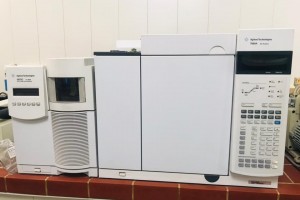
The College of Education for Pure Sciences, Department of Chemistry, University of Basra, discusses the preparation and characterization of some azo dyes and the study of their applications as corrosion inhibitors for carbon steel alloys in acidic medium and as acid-base scaling indicators.
The message presented by the researcher (Saba Hussein Ali) included
Preparation of four new compounds for homocyclic azo dyes, namely:-
S1/4-((2-nitro phenyl)diazenyl)naphthalene-1-ol
S2/4-((4-aminophenyl)diazenyl)naphthalene-1-ol
S3/4-((hydroxynaphthalen-1-yl)diazenyl)benzene sulfonic acid
S4/4-((hydroxyl phenyl)diazenyl)naphthalene-1-ol
These compounds were diagnosed using infrared (FT-IR), nuclear magnetic resonance (H1-NMR) and mass spectrometry.
The prepared azo dyes compounds were used as corrosion inhibitors for carbon steel N-80 in (1N HCl) solution. (1×10-3, 5×10-3, 1×10-2, 5×10-2) M and at different temperatures (298, 308, 318) K.
The results showed that the values of corrosion current density (Icorr) and corrosion rate (Rcorr) decrease with increasing concentration of the prepared inhibitors at constant temperature and increase with increase in temperature at constant concentration. And the difference in the values of the corrosion potential (Ecorr) in the presence of the inhibitor with different concentrations and at different temperatures in the acidic solution, and the values of the corrosion potential of the acidic solution in the absence of the inhibitor and at different temperatures is less than (85 mv), so the inhibitors are of the mixed type. The values of the percentage of inhibition efficiency (IE%) increase with increasing concentration of the prepared inhibitors at constant temperature and decrease with increasing temperature at constant concentration, which means that the adsorption is physical. The percentage values of the inhibition efficiency indicate that the inhibition efficiency of the prepared dyes follows the following order (S3 > S1 > S2 > S4), where the values of the inhibition efficiencies are (87 - 80.9 - 77.9 - 74.5) %, respectively, at the highest concentration of inhibitors (5 2×10 (M) and at the lowest temperature (298K).
Some thermodynamic functions of the corrosion and adsorption process were calculated, such as activation energy (Ea), change in free energy (ΔG), change in enthalpy (ΔH) and change in entropy (ΔS). (Langmuir adsorption isotherm) by calculating the adsorption equilibrium constant (Kads), which gave good results for the linear correlation coefficient (R2) that was close to the value of one for the inhibitors prepared with different concentrations.
The second axis included studying the effect of solvents (acetone, chloroform, dimethylformamide, dimethyl sulfoxide, ethanol, methanol) on the visible absorption spectra of the dye (S2), as the visible absorption spectra of the dye (S2) were measured in different polar solvents in a range of lengths. The wavelength ranged between (375-725)nm, as this study provides us with useful information about the nature of the interaction between the solvent and the solute.
The visible absorption spectra of the dye solutions (S2) were measured with a range of pH (1-12) using the buffer solutions within a range of wavelengths ranging from (375-725)nm. The spectra were characterized by the appearance of an absorption peak at the wavelength (477 nm) that is attributed to the absorption of the vulcanized formula of the dye present in acidic solutions. Distinctive between the two peaks at the wavelength (494nm). Depending on the obtained data, the ionization and protonation constants were calculated using the mid-height curve method, and the evidence range for the dye was found to range between (7.4 - 9.4), and suggested the ionization and protonation mechanism of the dye (S2). The azo dye (S2) has different colors as a result of the ionization and protonation processes of the dye, as it is orange in the acidic medium and blue in the basic medium. (strong base, weak acid - strong base) which gave the lowest quantitative estimation error when determining the end point of the reaction.
Aim of the study
Preparation of four azo dyes and their characterization by infrared (IR), proton nuclear magnetic resonance (H-NMR) spectroscopy, and mass spectrometry.
Inhibitory performance test and evaluation of the inhibition efficiency of the prepared compounds as corrosion inhibitors of carbon steel alloy in a solution of HCl (1M) using the Tafel Plot method.
Studying the effect of concentration and temperature on the rate of corrosion rate and the inhibition efficiency of the prepared compounds.
Calculating some thermodynamic functions ΔG, ΔH, ΔS, and kinematics Ea, and their relationship to the inhibition process.
And using the azo dye (S2) as an acid-base guide, and calculating the ionization and protonation constants with different acid-function solutions.
And study the effect of some organic solvents of different polarity on the absorption peaks of dye (S2).
Message inferred
Through the results obtained in this study, we were able to reach the following conclusions:-
The difference in the change in the erosion effort in the absence and presence of inhibitors is less than (85 mv), and this means that the inhibitors are of the mixed type.
And that the activation energy (Ea) is higher in the presence of the inhibitor than in the absence of it, and this proves the inhibition process for the prepared azo compounds, and that the positive values of (ΔH*) proved that the corrosion reaction is endothermic, while the increase in the negative values of (ΔS*) proved that There is randomness in the reaction, and positive values of (ΔG*) prove that the reaction is not spontaneous.
And that the adsorption of the inhibitor molecules on the surface of the alloy is subject to the Lancome adsorption isotherm








